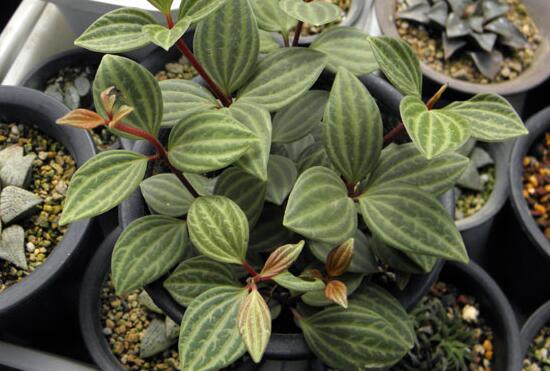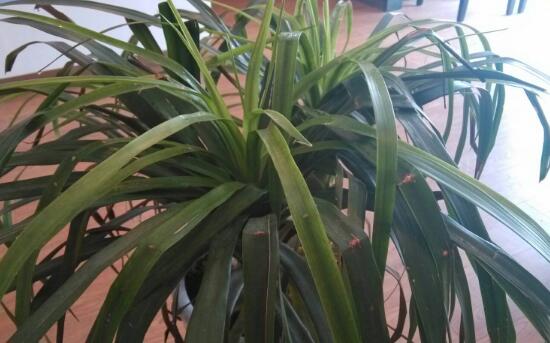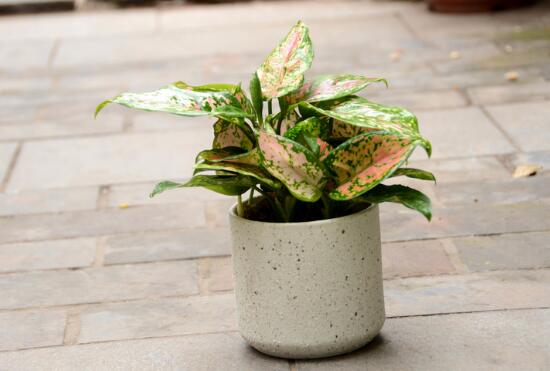What if the leaves of Capsicum bungeanum turn yellow? environmental ventilation / supplementary light / reasonable water and fertilizer
White pepper grass, also known as diamond emerald, is a recently introduced foliage plant, its small and exquisite plant type, white and green leaves, people like from the bottom of their hearts. But in indoor breeding, many novices will yellow the leaves of Capsicum bungeanum, thus affecting the ornamental nature of the plant. So, what if the leaves of Capsicum bungeanum turn yellow? Today, the editor is here to solve this problem for everyone.
What if the leaves of Capsicum bungeanum turn yellow?

With regard to the yellowing of the leaves of Zanthoxylum bungeanum, there are several reasons, and the solution is also simple: if the light is not enough, supplement the light; if the water and fertilizer is not appropriate, you can reasonably water and fertilize, and if the root is rotten, you need to take off the pot and cut the root. Then change the pot soil to plant again; if it is caused by diseases and insect pests, spray in time to control.
Second, the causes and solutions of yellowing leaves of Capsicum bungeanum L.
1. Environmental mutation
To talk about the reason why the leaves of Capsicum bungeanum turn yellow, the first thing we should consider is the problem with the environment. Nowadays, most of the potted plants of white pepper grass are bought online, which can easily lead to regional cross-service, the environment changes too much, and the white pepper grass can not adapt and the leaves are yellow.
Solution: it is very simple, if the newly bought white pepper grass appears leaf yellow, according to its growth habits, we provide it with the most suitable growth environment, after a period of time, the plant will return to health.
2. Too little light
Although Zanthoxylum bungeanum is shade-tolerant, as an ornamental plant, it also has a demand for light. Once it is changed in the dark for a long time, its leaves will turn yellow because of the lack of photosynthetic nutrients.
Solution: very simple, add light, but to avoid direct sunlight, especially in summer, be sure to shade, so as not to burn the leaves, the best way is to move the pot to a place with plenty of astigmatism.
3. Improper watering
White pepper grass likes a humid environment, but it avoids stagnant water, so watering can neither be more nor less. If the leaves are watered less, the leaves will naturally turn yellow if they do not get the supply of nutrients; if they are watered too much, they will cause stagnant water in the basin soil, and it will be difficult for the roots of the plants to breathe, and the leaves will turn yellow because they cannot absorb nutrients.
Solution: when watering is insufficient, replenish water in time, but do not water too much at once, just keep the basin soil slightly wet; when watering too much, loosen the soil and let the water evaporate quickly; if the roots have been soaked, you need to remove the plant from the pot. then cut off the rotten roots and replace them with heart-basin soil to plant again.
4. Improper fertilization
The leaves of Zanthoxylum bungeanum are large and dense, so they naturally need sufficient nutrients in the process of growth. Once the fertilizer is insufficient, the leaves will turn yellow easily if they do not get enough nutrients; however, if the fertilizer is too much or too thick, it may also lead to scorched yellow at the tip of the leaves, and in serious cases, it will also cause the leaves to fall off.
Solution: when applying too little fertilizer, you can add fertilizer, but to apply fertilizer, you must apply thin fertilizer frequently to avoid thick fertilizer and raw fertilizer; if you apply too much fertilizer, stop fertilizing immediately and irrigate to dilute the fertilizer. If the roots are burnt out, you need to take off the pot and cut the roots, and then change the pot soil to plant again.
5. Diseases and insect pests
In addition to the above, diseases and insect pests are also one of the reasons for the yellowing of the leaves of Capsicum officinalis. Although it is not easy to grow insects and get sick, in the case of improper maintenance and poor ventilation, it will also give birth to shell insects and suffer from root rot, which may lead to yellow leaves.
Solution: determine the specific diseases and insect pests, and then spray for control, as for what medicine to spray, you can refer to the prevention and control of diseases and insect pests.
Generally speaking, the breeding method of white pepper grass is not difficult, but because many flower friends are novices, it is inevitable that the symptoms of leaf yellow will appear. However, after reading the full text, I believe you have a clear mind, the leaf yellow problem can be solved in accordance with the above method. With regard to the yellowing of the leaves of the white pepper grass, the editor has introduced it here, hoping to give you some help.
How to do with the loss of leaves, shade / reasonable water and fertilizer / pest spray in summer
As a beautiful foliage plant, there are problems with the leaves of Capsicum bungeanum, which is often encountered and troublesome by flower friends. And because the white pepper grass is a recently introduced plant, so many flower friends do not know how to do the white pepper grass leaves. In this regard, the editor summed up several reasons for the loss of leaves and solutions for your reference, let's go and have a look!
1. What should I do if the leaves of the white pepper grass fall off?
To say that the white pepper grass leaves, in fact, there are only a few reasons: if it is caused by too strong light, shade maintenance can be; if the water and fertilizer is caused improperly, it is appropriate to water and fertilize, and if the root is rotten, you need to take off the pot and cut the root, and then change the pot soil to plant again; when you are attacked by diseases and insect pests, spray in time for prevention and control; if it is normal deciduous leaves, normal maintenance can be.
Second, the reasons for the loss of leaves of Capsicum bungeanum and its solutions.
1. The light is too strong
White pepper grass likes the semi-shady environment, sufficient scattered light can make it grow more luxuriant and green. However, in the summer sun, must be properly shaded, otherwise by the strong light, there will be white pepper leaves yellowing, or even the phenomenon of falling leaves.
Solution: if the leaves of the white pepper grass are sunburned, the flower friends should move the white pepper grass to the indoor semi-shade in time, pay attention to ventilation, and then water it properly after it slows down, and take good care of it for a period of time, the plant will return to health, and the leaves will slowly grow back.
2. Improper watering
Too little watering: White pepper grass likes the humid environment, the growth period needs sufficient water, once the watering is insufficient, the plant leaves can not absorb water, it will become dull and dull, and will fall off as soon as it is touched. Solution: replenish water, but don't water too much at once, wait for the leaves of Capsicum bungeanum to no longer fall behind and then turn to normal watering.
Overwatering: White pepper grass likes water, but it avoids stagnant water, once too much watering, resulting in stagnant water in the basin, resulting in root rot, but also prone to the phenomenon of falling leaves. Solution: stop watering, and often loosen the soil to make the soil well ventilated, and then slowly return to normal watering; if the root is rotten, you need to take off the pot and cut the root, and then change the pot soil to plant again.
3. Insufficient fertilization
Guanbai pepper grass, it has large and dense leaves, so it needs sufficient nutrients in the process of growth. Once the fertilizer is insufficient, the leaves will fall due to lack of nutrients.
Solution: in the growing period of Zanthoxylum bungeanum, mature thin liquid fertilizer or compound fertilizer can be applied every 2-3 weeks, and appropriate amount of water should be applied to dilute the fertilizer in the basin.
4. Diseases and insect pests
In fact, the reason for the loss of leaves of white pepper grass is also related to diseases and insect pests. It is understood that in the environment of poor ventilation and dry air, white pepper grass will give birth to shell insects and red spiders, which are small and harmful, often causing yellow leaves or even fallen leaves.
Solution: clean the insect body with water and spray relevant insecticides, specific what should be sprayed, you can refer to the prevention and control of diseases and insect pests.
5. Normal phenomenon
If you can rule out the above points, then the reason for the loss of leaves may be a normal phenomenon. It is understood that the newly bought pepper grass is easy to lose its leaves, and this is actually a very common thing, because although it has strong adaptability, it also needs a process of adaptation to the new environment. During this period, it usually loses its leaves.
Solution: when you encounter this situation, flower friends do not have to worry. You just need to put the potted plants in a place of astigmatism for maintenance, wait for the plants to recover slowly, and then water and fertilize them normally according to the breeding method of Capsicum bungeanum. It will slowly recover.
With regard to the treatment of the loss of leaves, after reading the omni-directional analysis of the above five aspects, we should know how to do it! In fact, the loss of leaves is caused by one reason, but it is often caused by a variety of factors, so when we encounter this situation, we must make a correct diagnosis, so that we can prescribe the right medicine to the case.
The diamond emerald leaves fall off as soon as they are touched, and it is the key to learn 5 ways to easily remedy / water and fertilizer.
Diamond jadeite, a beautiful foliage plant, has broad leaves and white and green leaves, so it is also called white pepper grass. In life, there are many people who raise diamond emeralds, but in the process of raising them, many flower friends will encounter the situation of losing their leaves. What if the diamond emerald leaves drop as soon as they are touched? Today, the editor is here to solve this problem for everyone.
First, the diamond emerald leaves fall off as soon as they are touched.
Diamond emerald leaves are dropped as soon as they are touched, and the solution is also simple: when the light is too strong, appropriate shade; water and fertilizer is inappropriate, it is suitable to water and fertilize, if the root is rotten, it is necessary to take off the pot and cut the root, and then change the pot soil to plant again; when attacked by diseases and insect pests, spray in time for prevention and control; if it is normal defoliation, normal maintenance can be done.
Second, the reasons for the loss of leaves of diamond jadeite and its solutions
1. The light is too strong
Diamond jadeite is suitable for growing under astigmatism. Once the light is too strong, it will grow poorly, and its leaves are easy to burn or even fall off.
Solution: if the diamond emerald leaves are caused by excessive light, flower friends timely move the plant to the indoor semi-shade, pay attention to ventilation, wait for it to slow down and then water it properly, and then carefully maintain for a period of time can be restored.
2. Improper watering
Diamond jadeite likes a humid environment and needs sufficient water in the process of growth. once it is not watered enough, the leaves of the plant cannot absorb water, and it will become dull and dull and fall off as soon as it is touched. At the same time, diamond jade avoid stagnant water, once too much watering, resulting in stagnant water in the basin, resulting in root rot, but also prone to the phenomenon of diamond jadeite leaves.
Solution: when watering is insufficient, replenish water, but do not water too much at once, wait for diamond jadeite leaves to no longer fall behind and then turn to normal watering; when watering too much, stop watering, and often loosen the soil, so that the soil is well ventilated, and then slowly return to normal watering; if the root is rotten, you need to take off the basin and cut the root, and then change the pot soil to plant again.
3. Insufficient fertilization
When it comes to the reason why diamond emerald leaves fall off as soon as they are touched, in addition to watering, insufficient fertilization can not be ignored. Diamond jadeite leaves are large and dense and need sufficient nutrients in the process of growth. Once the fertilizer is insufficient, the leaves will fall due to lack of nutrients.
Solution: during the growing period of diamond jadeite, mature thin liquid fertilizer or compound fertilizer can be applied every 2-3 weeks, and appropriate amount of water can be applied to dilute the fertilizer in the basin; usually, it is better to apply fertilizer with thin fertilizer, and the concentration should not be too high.
4. Diseases and insect pests
When it comes to the loss of leaves in diamond emeralds, it is actually related to diseases and insect pests. It is understood that in a poorly ventilated and dry environment, diamond jadeite will give birth to beetles and red spiders, which are small and harmful, often causing yellow leaves or even fallen leaves.
Solution: clean the insect body with water, and spray related insecticides, specific what to spray, you can refer to diamond jadeite pest control.
5. Normal phenomenon
Newly bought diamond jadeite is easy to lose leaves, and this is actually a very common thing, because although diamond jadeite is adaptable, it also needs a process of adaptation to the new environment. During this period, it usually loses leaves.
Solution: when you encounter this situation, flower friends do not have to worry. You just need to put the potted plants in a place of astigmatism for maintenance, wait for the plants to recover slowly, and then water and fertilize normally according to the cultivation method of diamond jadeite. It will slowly recover.
Encounter diamond emerald leaves touch off, after reading the above five aspects of the omni-directional analysis, we should know how to do it! In fact, the loss of leaves of diamond jade is caused by one reason, but it is often caused by a variety of factors, so when we encounter this situation, we must make a correct diagnosis, so that we can prescribe the right medicine to the case.
- Prev

What if the leaves of asparagus turn yellow, replenish the light / warm up in winter / reasonable water and fertilizer
Asparagus, a beautiful foliage plant, has beautiful shape, leaves such as weeping willow, pure color, and is very ornamental at home. For veterans, asparagus is a kind of green plant that is easy to raise, but for novices, the leaves of asparagus always turn yellow, so what about the yellowing of leaves?
- Next

What if the leaves of Ruyi Queen turn yellow, supplement light / reasonable water and fertilizer / change soil and replant
Keeping a pot of evergreen at home is definitely a good choice, and as a boutique inside, Ruyi evergreen, also known as Ruyi Queen, can be said to be loved by flower friends. However, in the process of breeding, the queen with gorgeous leaves will often show symptoms of yellowing, so what about the yellowing leaves of the queen?
Related
- Fuxing push coffee new agricultural production and marketing class: lack of small-scale processing plants
- Jujube rice field leisure farm deep ploughing Yilan for five years to create a space for organic food and play
- Nongyu Farm-A trial of organic papaya for brave women with advanced technology
- Four points for attention in the prevention and control of diseases and insect pests of edible fungi
- How to add nutrient solution to Edible Fungi
- Is there any good way to control edible fungus mites?
- Open Inoculation Technology of Edible Fungi
- Is there any clever way to use fertilizer for edible fungus in winter?
- What agents are used to kill the pathogens of edible fungi in the mushroom shed?
- Rapid drying of Edible Fungi

